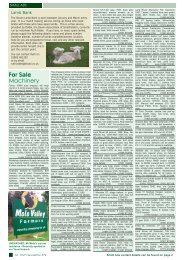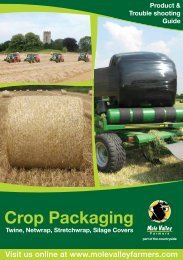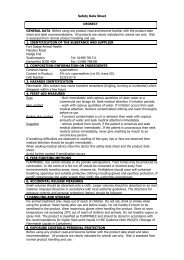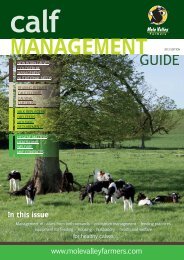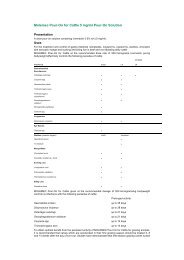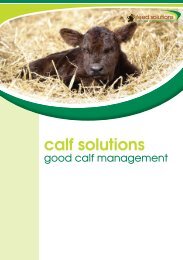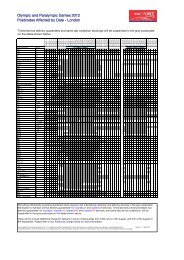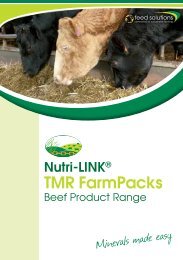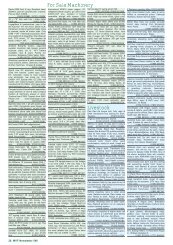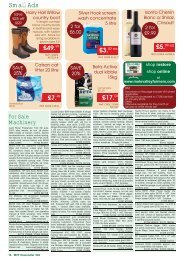VITAX SAFETY INFORMATION SHEET - Mole Valley Farmers
VITAX SAFETY INFORMATION SHEET - Mole Valley Farmers
VITAX SAFETY INFORMATION SHEET - Mole Valley Farmers
Create successful ePaper yourself
Turn your PDF publications into a flip-book with our unique Google optimized e-Paper software.
<strong>VITAX</strong> <strong>SAFETY</strong> <strong>INFORMATION</strong> <strong>SHEET</strong><br />
IDENTIFICATION OF PREPARATION SBK BRUSHWOOD KILLER<br />
Packaging: 125ml, 250ml, 500ml & 1 litre HDPE bottles packed in cardboard<br />
boxes.<br />
AND COMPANY Vitax Ltd, Owen Street, Coalville LE67 3DE Tel: 01530 510060<br />
COMPOSITION Soluble concentrate containing:<br />
INGREDIENT % w/w CLASSIFICATION CAS NO EC NO<br />
Triclopyr triethylamine salt 6.4% Xi R41-43-52/53 057213-69-1 260-625-1<br />
Triethylamine
Spillages: soak up with sand or other non-combustible absorbent material and place<br />
into containers for disposal. For large spills, barricade area and consult<br />
manufacturer. If further assistance is required, telephone the emergency number.<br />
HANDLING & STORAGE Handling: use good personal hygiene. Do not consume or store food in the work<br />
area. Wash hands and exposed skin before eating, drinking or smoking and after<br />
work. Avoid eye and skin contact.<br />
Storage: product should be stored in compliance with local regulations. Store in a<br />
cool, dry, well-ventilated place in the original container. Protect from excessive heat<br />
and cold. Do not store near food, drink, animal feeding stuffs, pharmaceuticals,<br />
cosmetics or fertilisers. Keep out of reach of children.<br />
EXPOSURE CONTROLS/ Exposure Guidelines:<br />
PERSONAL PROTECTION Triclopyr: Dow AgroSciences IHG is 2 mg/m 3 (skin)<br />
Engineering Controls<br />
Good general ventilation should be sufficient for most conditions. Local exhaust<br />
ventilation may be necessary for some operations.<br />
Respiratory Protection<br />
For most conditions, no respiratory protection should be needed. However, when<br />
airborne exposure guidelines and/or comfort levels may be exceeded use an<br />
approved air-purifying respirator.<br />
For emergency conditions, use an approved positive-pressure self-contained<br />
breathing apparatus.<br />
Hand/Skin Protection<br />
For brief contact, no precautions other than clean body-covering clothing and<br />
impervious gloves should be needed. When prolonged or frequently repeated<br />
contact could occur, use protective clothing impervious to this material.<br />
For emergency conditions: use protective clothing impervious to this material.<br />
Selection of specific items will depend on operation.<br />
Eye/Face Protection<br />
Use chemical goggles.<br />
PHYSICAL & CHEMICAL Appearance pale yellow liquid<br />
PROPERTIES pH 7.5-9.5<br />
Relative density 1.02 approx (20 deg C)<br />
Solubility soluble<br />
Flash point 65 deg C (PMCC)<br />
Other data none<br />
STABILITY & REACTIVITY Stability: Stable under normal conditions<br />
Conditions to avoid: avoid extremes of temperature<br />
Materials to avoid: strong basic, acidic or oxidising materials.<br />
Hazardous decomposition products: none under normal conditions of storage and<br />
use.<br />
TOXICOLOGICAL <strong>INFORMATION</strong> Acute toxicity: based on data for similar formulation.<br />
Oral: LD50 (rat) > 2000 mg/kg<br />
Dermal LD50 (rat) > 2000 mg/kg<br />
ECOLOGICAL <strong>INFORMATION</strong> Aquatic Toxicity<br />
Material is not harmful to fish on an acute basis (LC50>100mg/L)<br />
Material is not harmful to aquatic invertebrates on an acute basis (EC50>100mg/L)<br />
Material is not harmful to algae (IC50 >100mg/1)<br />
Avian Toxicity<br />
Material is practically non-toxic to birds on an acute basis (LD50 >2000mg/kg)<br />
Persistence and Degradability: degradation is microbially mediated and occurs<br />
readily, dependent on conditions.<br />
DISPOSAL CONSIDERATIONS Do not contaminate ponds, waterways or ditches with chemical or used container.<br />
Wash out thoroughly. Container and washings must be disposed of safely and in<br />
accordance with applicable regulations. The preferred options are to send to<br />
licensed reclaimer or to permitted incinerators. Do not re-use container for any<br />
purpose.<br />
TRANSPORT <strong>INFORMATION</strong> Product is not classified for any mode of transportation. Sample shipment not<br />
allowed by mail.
REGULATORY <strong>INFORMATION</strong> Hazard Symbol: none, not classified as hazardous<br />
OTHER <strong>INFORMATION</strong> Risk phrases in Section 2<br />
R11 - Highly flammable<br />
R20/21/22 - Harmful by inhalation, in contact with skin and if swallowed<br />
R35 - Causes severe burns<br />
R41 - Risk of serious damage to eyes<br />
R43 - May cause sensitisation by skin contact<br />
R52/53 - Harmful to aquatic organisms, may cause long-term adverse effects in the<br />
aquatic environment.<br />
The information contained in this sheet is based on the best available information,<br />
including data from test results.<br />
October 2006




